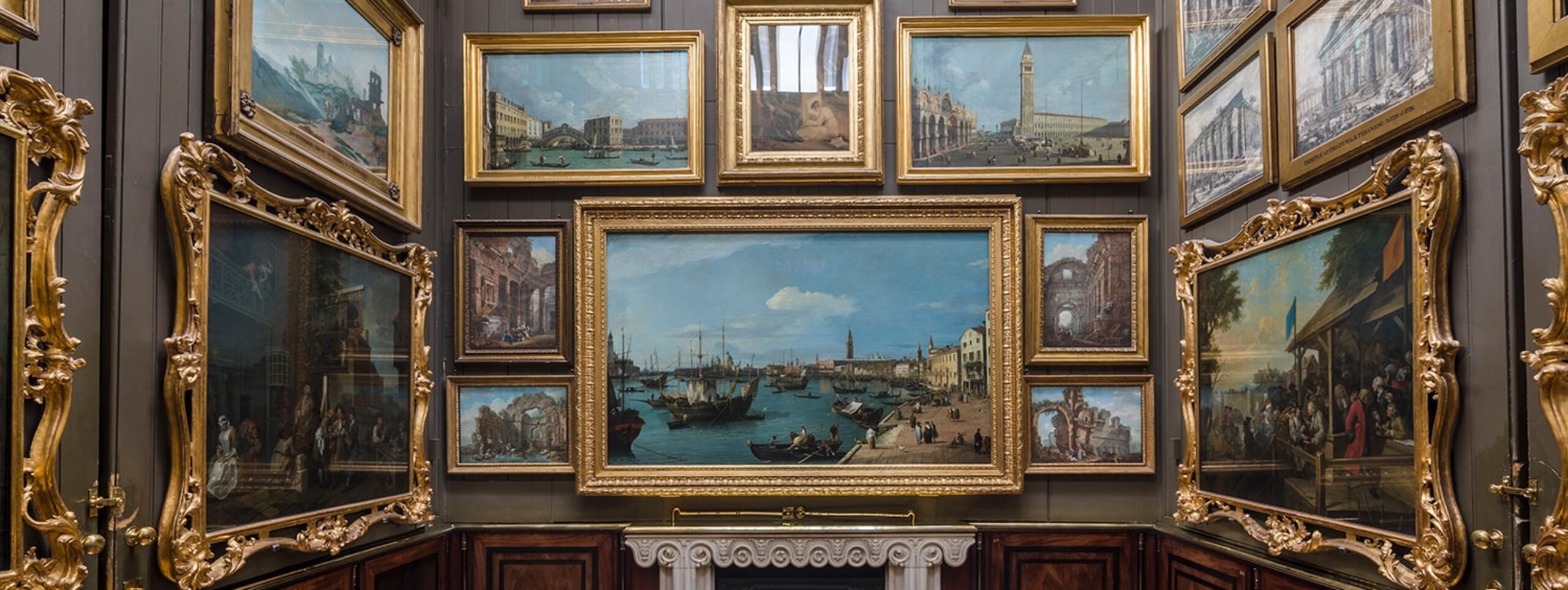The Picture Room contains some of Sir John Soane’s most treasured works of art, including masterpieces by Hogarth, Canaletto, Turner and Piranesi. Soane used moving ‘picture planes’ to allow him to hang a small 13-by-12-foot room with 118 paintings, a collection large enough for a room three times its size.
You can also learn about the Picture Room in our Highlights Film. Find out more >
A Rake’s Progress: The Conservation
We are starting restoration of our iconic A Rake’s Progress (a series of 8 pictures), painted by William Hogarth c.1734. The whole project will take several years, concluding, we hope, around April 2027. The work is now underway, which will see each canvas treated over the course of the conservation programme. Facsimiles are being used to complete the set in the Picture Room when individual paintings are away being restored. The conservation is being carried out in response to detailed assessments of these national treasures by a number of different specialists who have identified that urgent work is required to ensure the pictures continue to delight future generations.
Hogarth's 'modern moral subjects' Back to top
William Hogarth (1697 - 1764), An Election I: The Election Entertainment, 1754-55, Oil on canvas.
Renowned English artist William Hogarth (1697–1764) is best known for his series of paintings and engravings which depict ‘modern moral subjects’. Filled with dark humour and bawdy satire, these narrative series mock the excesses of Georgian society and warn of the consequences of moral abandonment. Sir John Soane purchased two of Hogarth’s series, A Rake’s Progress and An Election.
The four-part An Election is based on a real-life election in Oxfordshire between the Whig and Tory parties in 1764, satirising the corruption rife at every level in both camps. In I: The Election Entertainment, the Whigs hold a riotous dinner for powerful friends. The Mayor has fainted after gorging on oysters, a servant empties a chamber pot out of the window into the Tory demonstration outside, and one of the candidates, flirting with a fat old woman, is unaware his wig is being set on fire. In II: Canvasing for Votes, a young farmer is offered bribes by agents of both, and in III: The Polling, mentally unsound and dying or perhaps even dead voters are being brought to the polling, whilst in the background, a coach carrying an allegory of Britannia has broken apart, whilst its drivers, unaware, are absorbed in a game of cards. The final scene, IV: Chairing the Member, depicts a vicious fight erupting as the victorious candidate is paraded through the streets. As well as its political content, An Election is notable as perhaps Hogarth’s finest painted series, filled with still-life details and pastoral landscapes, and represents his desire to be seen as an artist as well as a political satirist.
Displayed behind the picture planes on the north wall, A Rake’s Progress is one of Hogarth’s earlier series, telling the eight-part story of the fictional Tom Rakewell. This young man inherits a fortune from his miserly father, but squanders it, following a path to vice and destruction. In the opening scene, The Heir, Rakewell coldly discards his pregnant, lower-class fiancé Sarah Young, even as he is measured for a new suit. In The Orgy, he is obliviously drunk at the Rose Tavern in Covent Garden, too intoxicated to notice that his pocket watch is being deftly stolen by prostitutes. By the final scene, The Madhouse, after losing multiple fortunes and enduring Debtor’s prison, he lies naked and insane in Bedlam madhouse as a grieving Sarah Young mourns.
Canaletto’s views of Venice Back to top
Antonio Canaletto (1697 - 1768), Riva degli schiavoni, Venice, c.1734-35, Oil on canvas
Soane purchased three paintings by Canaletto, including the Riva degli Schiavoni, one of the Italian painter’s greatest works, which hangs opposite the doorway to the Picture Room. Depicting an almost photographically-rendered view of the famous promenade in Venice, with the Salute, San Giorgio and San Marco visible in the distance, the painting also gives a snapshot of life in the city, with a myriad of ships moored in the lagoon and figures from all walks of life depicted in immaculate detail. Two further Canalettos, a view of the Rialto Bridge, and a view of the Piazza San Marco, flank the painting on either side.
Drawings by Piranesi Back to top
Giovanni Battista Piranesi, (1720 - 1778), Paestum (Italy), Basilica: view of interior from the East, c.1777-78
The great draughtsman Giovanni Battista Piranesi was keenly interested in the architecture of the ancient world. Sir John Soane met him in person in 1778 during his Grand Tour, a meeting that would greatly influence Soane’s later work and his fascination with ruins and fragments. The Picture Room contains a number of Piranesi works, some given to Soane by the artist. On the South wall as you enter, a group of ink and wash drawings depict the temples of Paestum in southern Italy, one of Soane’s favourite classical sites. These works are now replaced with facsimiles: read below to find out more.
Conserving the Picture Room Back to top
To avoid irreparable light damage, a number of the more fragile artworks in the Picture Room have been removed and replaced with facsimiles. These include the Piranesi drawings, and a number of works in the Picture Room Recess. We continue to fundraise to install facsimiles of these works to return the Picture Room to its former splendour. Find out more about how you can support the Museum.



